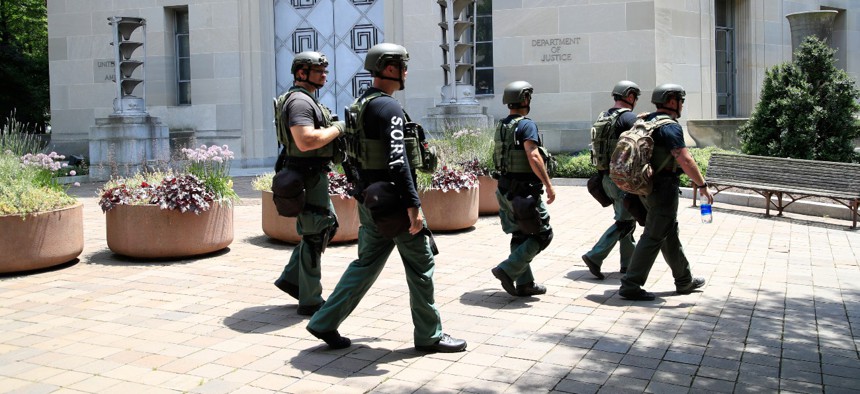
Officers walk outside the Justice Department as Attorney General William Barr speaks during a virtual press conference inside the building Thursday on the government's role in protest response. Manuel Balce Ceneta / AP
Here's What Deployed Federal Agencies Say They Are Doing During Protests
Federal personnel are deployed across the country to support local police and investigate "agitators" who have "hijacked" the police brutality protests.
Federal agencies will continue their deployments of personnel to protests across the country, top officials said on Thursday, with employees involved in a variety of investigations, crowd control and enforcement of curfews.
The ongoing presence will remain primarily in Washington, despite consecutive nights of peaceful protests leading to the mayor there eliminating any curfew. Most of the personnel come from the Justice Department, though the Homeland Security Department has deployed Federal Protective Service and Customs and Border Protection employees. In Washington, the Secret Service and Interior Department’s U.S. Park Police are the lead federal agencies assisting local police in engagement with protestors. The National Guard and active duty troops have deployed in the nation’s capital and in states around the country.
The federal government has made 51 arrests since protests broke out last week in response to the death of George Floyd, an unarmed black man killed by police in Minnesota, according to Attorney General Bill Barr. The mostly peaceful protests have led to some vandalism and looting, which federal officials repeatedly highlighted during a press conference on Thursday. Barr said 114 law enforcement—mostly federal officers—have been injured during the protests, including 22 hospitalizations primarily for head injuries. He did not detail how many protesters were injured or hospitalized at the hands of law enforcement.
The agency leaders all said they supported peaceful protests and changes in law enforcement practices, but suggested many demonstrations had been exploited or “hijacked” by “extremists” and agitators to commit criminal activity.
“While many have peacefully expressed their anger and grief, others have hijacked protests to engage in lawlessness, violent rioting, arson, looting of businesses and public property, assaults on law enforcement officers and innocent people, and even the murder of a federal agent,” Barr said, referring to an FPS officer who was killed in Oakland last Friday. “Such senseless acts of anarchy are not exercises of First Amendment rights.”
House Speaker Nancy Pelosi, D-Calif., demanded on Thursday more information on the role of each federal agency involved in the D.C. protests.
“We have seen soldiers on the steps of the Lincoln Memorial,” Pelosi said in a letter to President Trump. “We have witnessed Bureau of Prisons officers in Lafayette Square. We have seen National Park Service officers hassling peaceful protestors." She added: "Congress and the American people need to know who is in charge, what is the chain of command, what is the mission and by what authority is the National Guard from other states operating in the capital."
Here are the tasks Justice Department officials said their employees are carrying out:
FBI: Director Chris Wray said the bureau has deployed its 200 Joint Terrorism Task Forces around the country “to assist law enforcement with apprehending and charging violent agitators who are hijacking peaceful protests." He explained FBI agents are working with the bureau's law enforcement partners to gather as much information as they can on those agitators as they work to identify, investigate and stop them. “Many have suffered from the violence instigated through these radicals and extremists,” Wray said, adding he could not share any intelligence to support his claims. The bureau has set up 24-hour command posts at all of its 56 field offices.
U.S. Marshals Service: Marshals around the country are helping to protect federal buildings, agency Director Donald Washington said, noting that 21 federal courthouses were vandalized across the country in addition to other federal buildings. Washington added USMS is assisting other agencies, working violent crime warrants and “investigating gang activities that incite rioting.”
Bureau of Alcohol, Tobacco, Firearms and Explosives: Regina Lombardo, ATF’s acting director, said her agency’s agents across the country are responding to shootings and the use of explosive devices such as Molotov cocktails occurring during protests. ATF has deployed “every available resource” and a “large number” of agents from its special response team to protect people, property and public landmarks, Lombardo said. The bureau is investigating seven cases of arson that have taken place in D.C. in addition to incidents in Minneapolis and elsewhere.
Bureau of Prisons: BOP has deployed crisis management teams that typically respond to prison disturbances to provide assistance to other law enforcement agencies and support crowd control efforts. The teams are present both in Washington and Miami and were deputized by USMS. The bureau has come under fire after its officers posted in downtown Washington had no markings of their affiliation on their uniforms and declined to share that information with reporters. BOP Director Michael Carvajal took responsibility for the incidents, but said the officers were not operating under any order to withhold their affiliation.
Drug Enforcement Agency: The DEA is investigating looting that has taken place at pharmacies across the country and is conducting threat assessments in real time. It has deployed 150 agents in D.C. to provide a security perimeter and has 11 mobile teams at the ready for “high-risk situations.” Tim Shea, DEA’s acting administrator, praised his agents for their professionalism as protestors threw rocks at their vehicles and launched insults.
Justice did not respond to an inquiry into how many employees are deployed from each of its components. See what the federal response in Washington looks like here.







